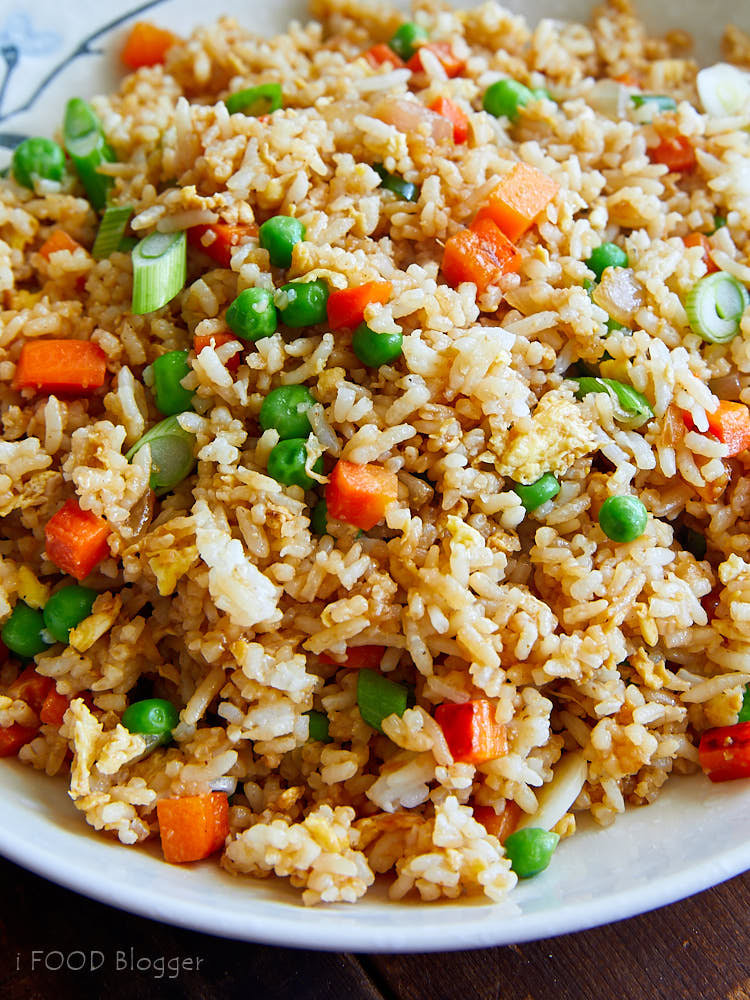
Do you like hibachi-style fried rice? You know, that delicious fried rice that they prepare on a huge, flat metal grill? Sometimes with the flames rising to the ceiling? I order it every time I get an opportunity as it tastes so good. Well, here is some great news – you can make this delicious fried rice at home in no time. It’s super easy to make and doesn’t require any special ingredients.
Now, you will need the right equipment though. Don’t worry, I am not talking about a monster hibachi griddle in the middle of your kitchen. By definition, the Japanese word hibachi means "fire bowl". Traditionally, hibachi refers to an open-top ceramic bowl that contains burning charcoal for heating purposes. In North America, the word hibachi is commonly used to describe an iron hot plate or a flat grill. At home, all you will need is a flat bottom wok for this task. It will perfectly simulate the high heat grilling achieved on a hibachi grill.
Can you use a regular frying pan? Yes, but the rice will be different. I prefer the result I get from a wok. My favorite wok is a non-stick, scratch resistant flat bottom wok. I love how my favorite Asian dishes I made in it turned out, and my homemade Japanese fried rice was no exception.
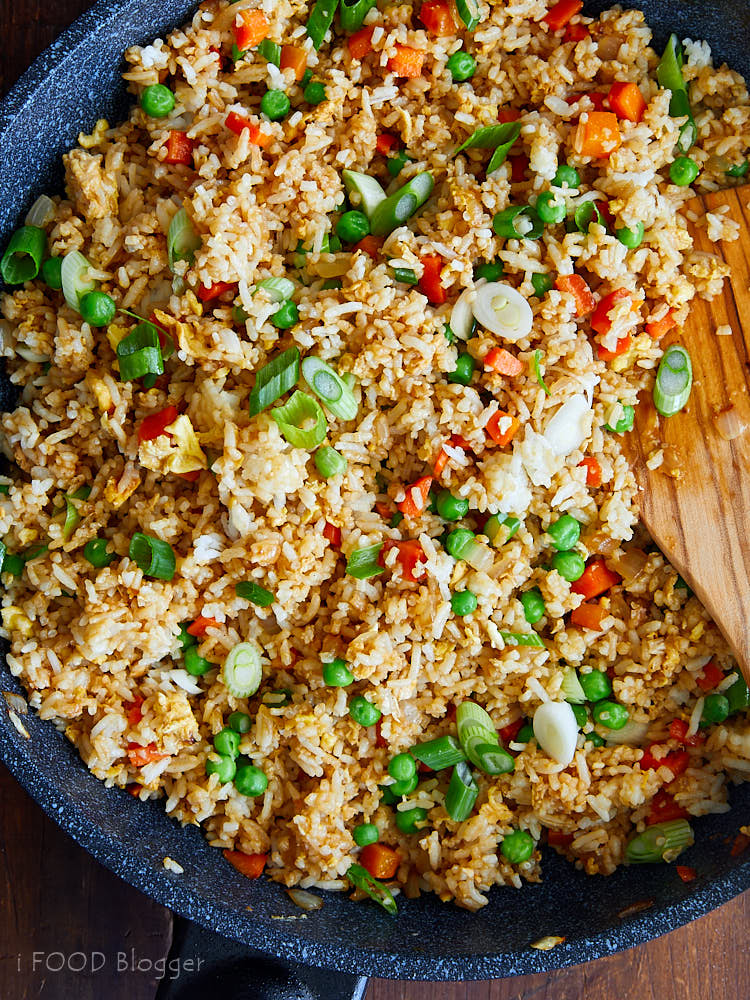
Interestingly, at our home we also use this wok for non-Asian dishes due to its superb capabilities. My wife loves using it to make fried eggs because of how they turn out in it. We now use either this wok or the cast iron pan for most of our stove-top frying.
When making hibachi-style fried rice I like to incorporate the same tricks that professional chefs do. A relative of a friend of mine owns a hibachi restaurant. He once told me that his secret for great hibachi fried rice is lots of butter and soy sauce. And a day old rice, which doesn't clump together and makes for better fried rice. Many places tend to use cheaper short grain rice, but jasmine is the best, so I use that at home.
Also, did you notice how they cover vegetables with a bowl on the grill? Doing so is critical to making perfectly tender vegetables without drying them out. At home, I saute vegetables over a fairly high heat until I get nice caramelization, then lower the heat and cover them with a small lid that goes right inside the wok. The lid prevents steam from escaping, which in turn helps soften the vegetables in a matter of a few minutes.
Also, try using white pepper instead of black pepper for that peculiar taste. Many hibachi places use it for fried rice.
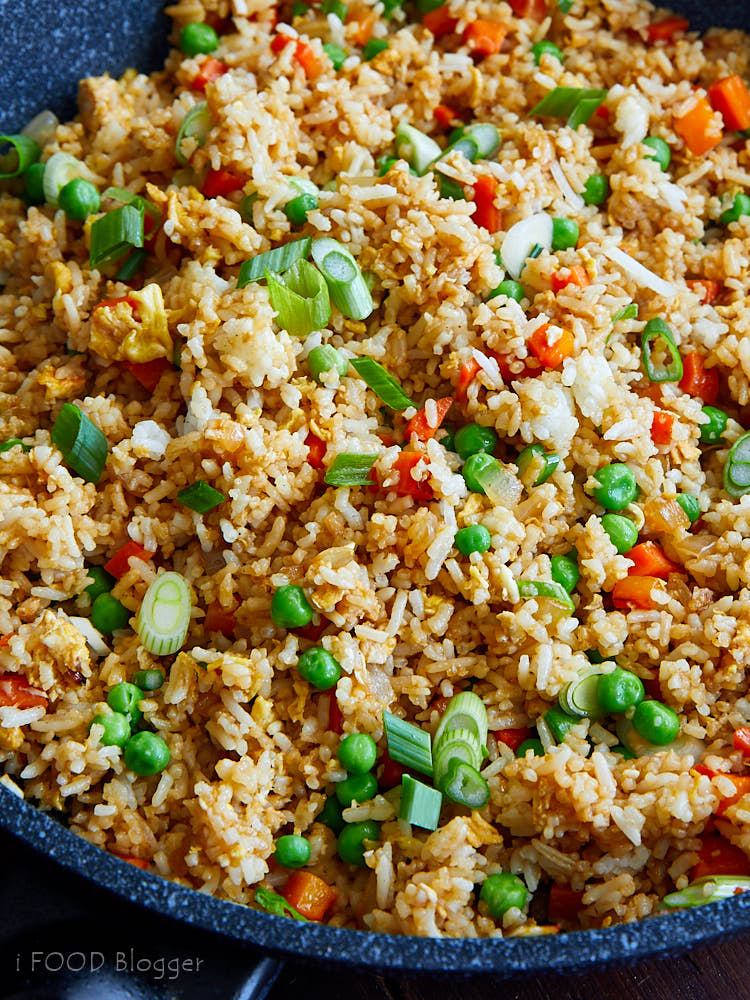
In my recipe I use a combination of low sodium and regular soy sauce because it gives me the perfect balance of flavor and saltiness. For an even lower sodium version, substitute regular soy sauce with low sodium. Alternatively, use all regular soy sauce for a saltier version. Japanese fried rice is often served with grilled chicken at restaurants. My favorite variant is to use leftover roasted chicken with the fried rice. It makes it a complete dish.
I don't know if this is customary, but I’ve seen many chefs add butter to make their fried rice taste richer and more flavorful. Butter really elevates this dish to a new level. And if you like spicy stuff, add some hot chili oil into your rice.
Try this rice with my hibachi chicken, which rivals the chicken from even the best hibachi restaurants and only takes 10 minutes to make.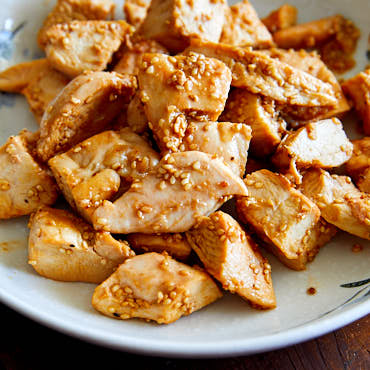
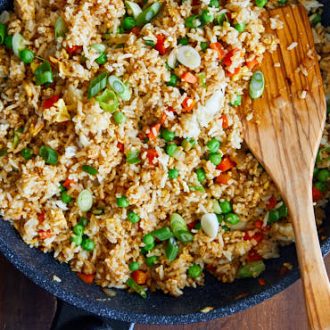
Japanese Fried Rice (Hibachi Style)
Ingredients
Step 1:
- 2 Tbsp peanut oil (or canola, or olive oil)
- ½ cup finely diced carrots
- ½ cup finely diced white onion
- 2 garlic cloves (minced)
Step 2:
- 2 eggs (lightly whisked)
Step 3:
- 3 cups cooked jasmine rice (or any long-grain rice)
- 2 Tbsp regular soy sauce
- 2 Tbsp low sodium soy sauce
- 1 tsp hot chili oil (optional)
- 3 Tbsp unsalted butter (optional if you want a healthier version, but strongly recommended for that great taste)
- 1/2 tsp white pepper
Step 4:
- ½ cup frozen peas
- ½ cup green onions (sliced on the diagonal about 1/2 “ long)
- 1 cup diced grilled chicken (optional)
Instructions
- In a wok, heat peanut oil over a fairly high heat. Add the vegetables and saute for about 2-3 minutes, frequently stirring, until nicely caramelized. To help the vegetables soften up, lower the heat to medium and cover them with a small lid placed inside the wok. Let saute for another 3-5 minutes, stirring every 1 minute or so, until the vegetables are soft enough.
- Crank the heat up to medium-high. Move the vegetables over to the side of the wok and add the eggs. Cook as you would scrambled eggs, frequently scraping and mixing with a spatula. Mix in with the vegetables.
- Add the rice and the soy sauce. Optionally, you may add unsalted butter for richer, buttery taste and/or hot chili oil for some heat. Sprinkle the white pepper. Mix with vegetables and saute for about 3-4 minutes, constantly stirring and trying to break up any rice clumps.
- Finally, add the frozen peas and the green onions and continue sauteing for another minute. A cup of diced left-over chicken is always a nice addition to hibachi rice, if you have some on hand. If you add the chicken you may have to cook an extra minute or so, until the chicken has warmed up.
Notes
Nutrition


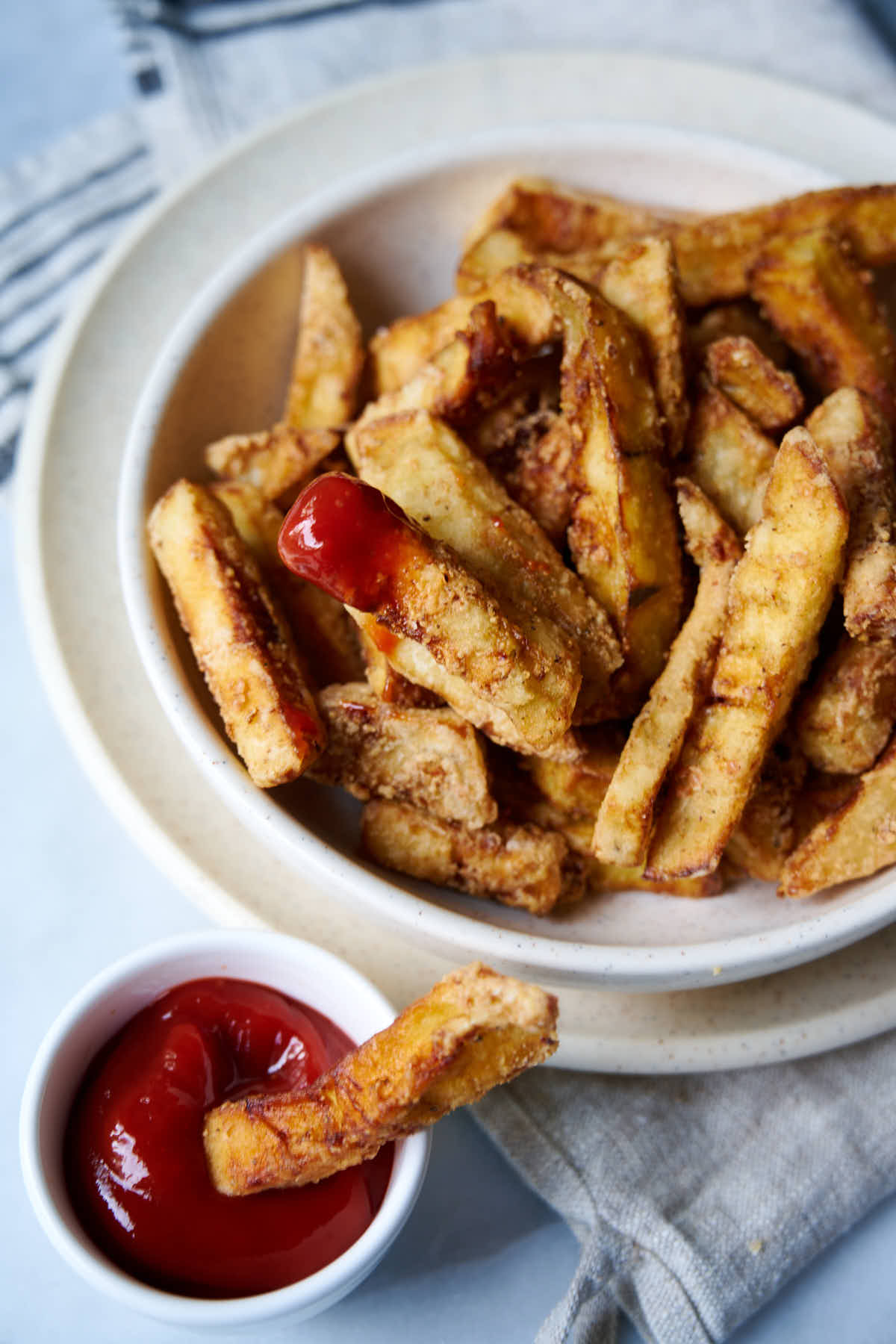
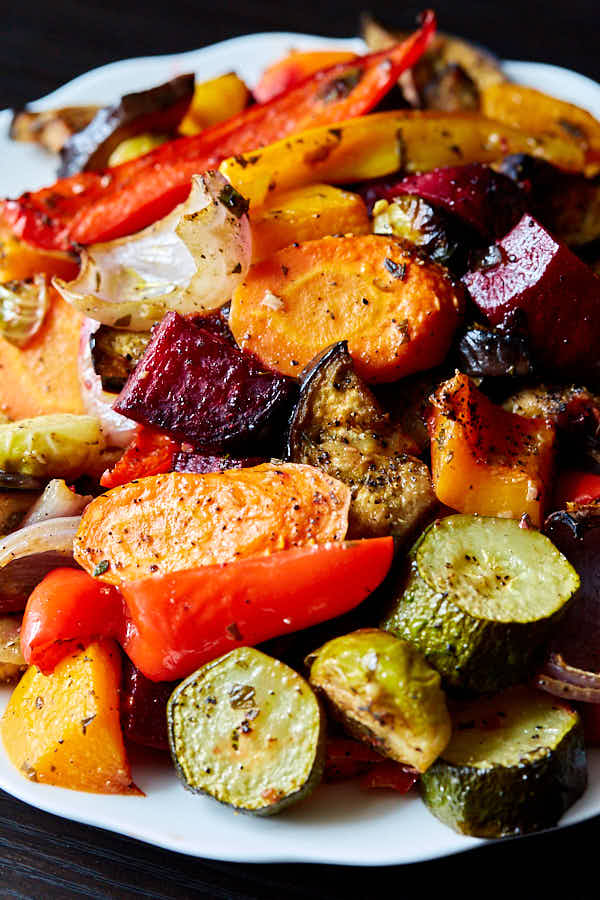
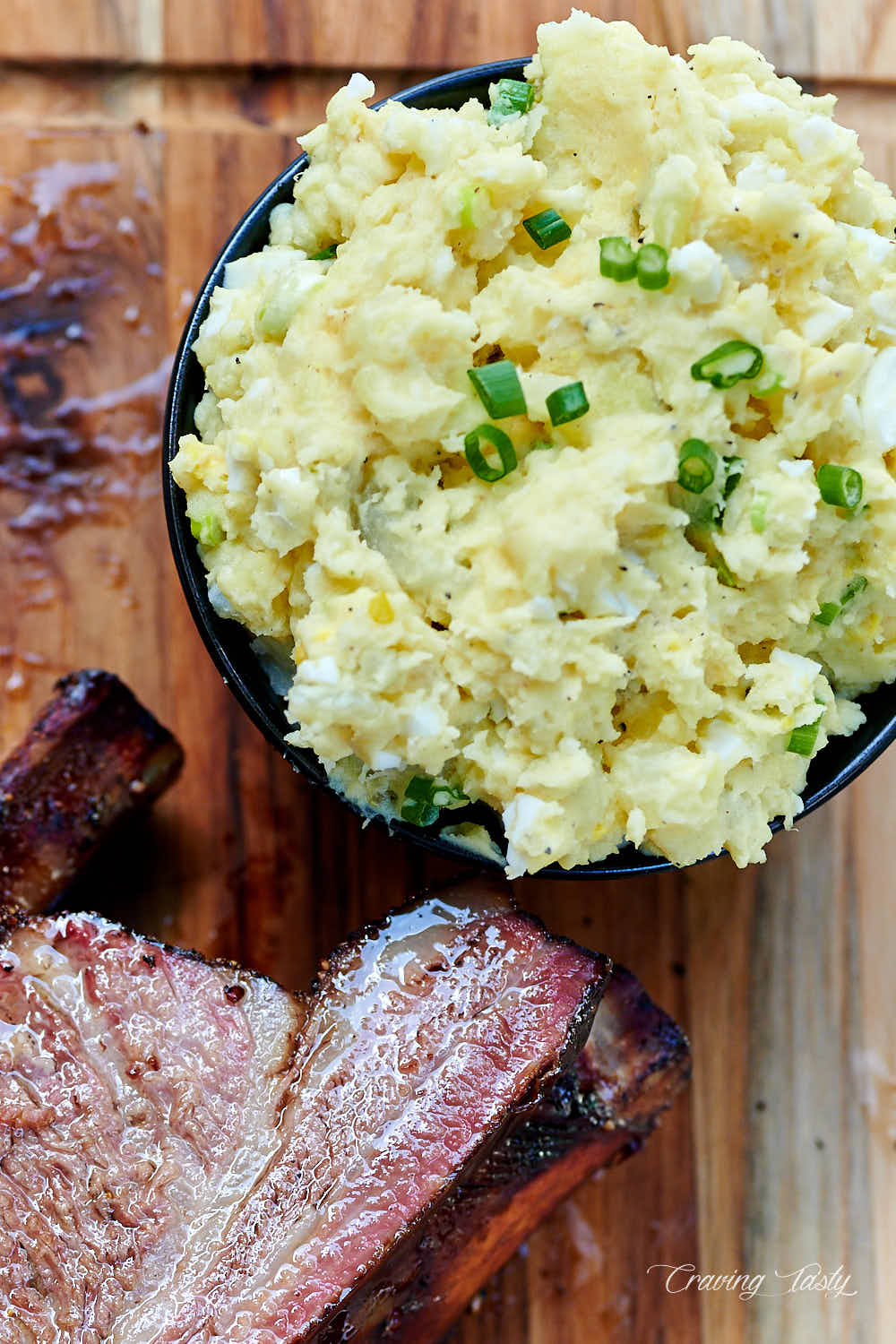
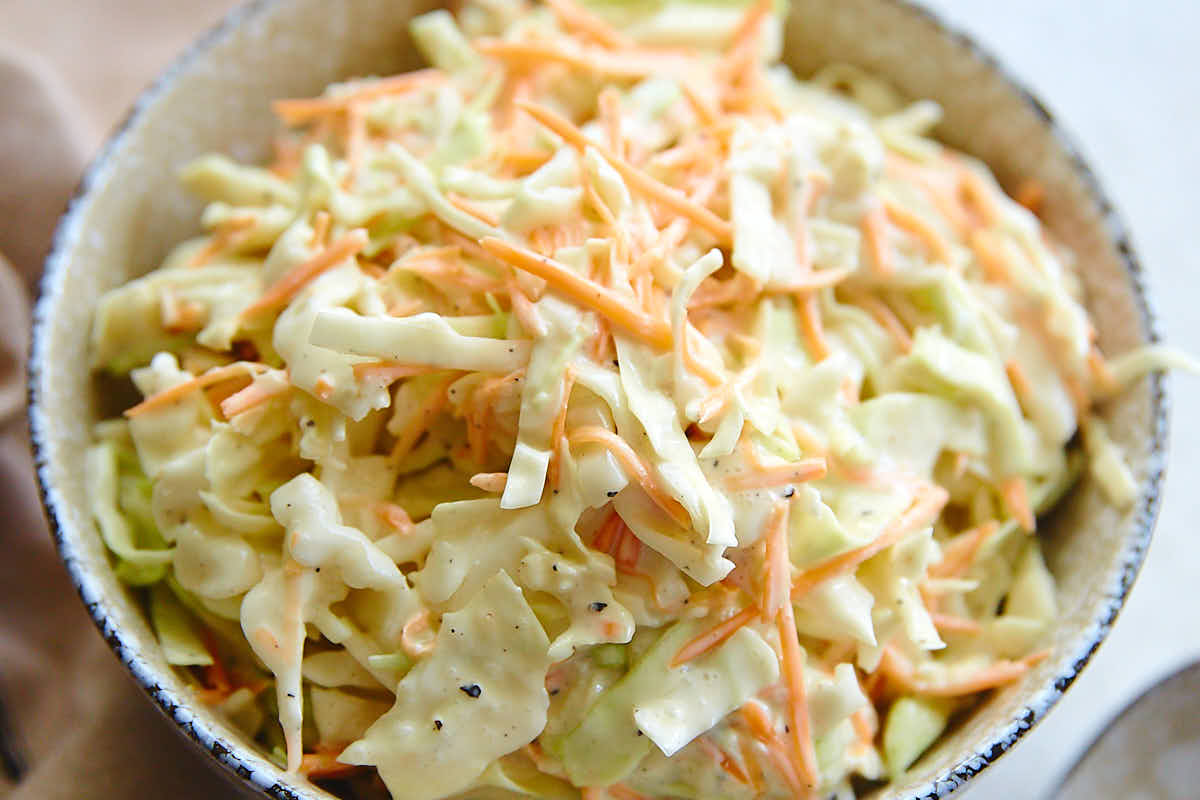
Julie says
Wonderful, simple yet very tasty recipe. Followed recipe exactly, it was stellar. BF likes his spicier, so he added some chili garlic sauce to his at the end. Thank you so much for creating and publishing this recipe!!
victor says
You are very welcome, enjoy!
Cindy Scott says
This was so good! My whole family gobbled it up! Next time, I might reduce the pepper a bit for our taste.
Fantastic recipe. Thank you!
victor says
You are very welcome!
Candy Williams says
Very tasty! Best advise from this recipe - lots of butter and lots of soy sauce.
MichelleK says
Absolutely perfect as is.
victor says
Glad you like it. My family loves this recipe.
Ali says
Incredibly tasty and very easy.
I did add a little ginger since I had some left over from a marinade I also made and used edemame instead of peas since that is what I had but my husband gave it 3 thumbs up and he's picky about his hibachi style fried rice.
Bkhuna says
You can't make fried rice on a hibachi because the rice will fall through the grate. A hibachi is a wood or coal fired grill with some type of grate.
You probably meant teppanyaki rice. A teppan is a flat steel "griddle" for frying.
Common mistake.
Greg Harrington says
Great recipe. Given the comments I have read it is highly regarded by those whom have tried it. A couple of tips (could be personal preference) that help my fried rice is A.) Cook 2 eggs in a separate pan on medium-low heat. Mixing and folding, then just before done (the tiniest bit runny) remove from pan all together and place on a separate plate. The egg cooks slightly while completing the process for the perfect texture and consistency. Only add at the very end. You want to "warm" the egg back up, not recook it.
B.) I like to add about a tsp of ground ginger or 1" of fresh ginger finely chopped. Also, I add a few "squirts" of my favorite sake in the soy/butter mix (I keep it in a condiment bottle for cooking)
C.) Considerimg trying water chestnuts or bean sprouts (added the last couple minutes of cooking) for a little crispy texture. You wont regret it.
victor says
Great tips, Greg, thank you for your input.
Claudine says
Made it tonight. It is the best fried rice I have ever made. Tastes like it’s from my favorite Thai restaurant.
victor says
Happy to hear that. My family loves this rice and we make it more often than any other rice. I even bought a bigger carbon steel wok so I can make more for when we have guests over.
Rob says
First time I've ever tried to make a dish like this and this recipe was absolutely perfect, used finely chopped zucchini instead of peas and it fit very well.
Riley Owens says
Does the rice need to be pre cooked?
victor says
Yes, the recipe calls for cooked rice.
Brittany says
Honestly the best Hibachi-style recipe I have ever made. Thank you!
Steph says
Made this and your hibachi chicken for dinner tonight. I have never seen my husband eat so fast in his life! Pretty sure we won’t be going out for Japanese food anymore!
Teddy Crowther says
Hey!
I’ve tried to make fried rice before, the soy sauce always ends up being a different taste than the restaurants. Any reccomendations on which type to get?
victor says
Oh, that's a hard one to answer for many reasons. That said, I use the Kikkoman's low sodium soy sauce and love the taste.
Stanley says
This is a great quick hibachi rice recipe, highly recommend.
Pari says
Hi Victor, I made this yesterday for dinner and my family loved it! The only change I made was I added some tomato ketchup. We usually eat this at our local Japanese restaurant and my kids love the fried rice there. I think I can make your recipe now whenever we crave for it 🙂 Thanks a lot for such an easy and yummy recipe.
victor says
You are very welcome, Pari. Glad to hear that you and your family loved my recipe. I love this fried rice, it's so tasty and so addictive!
Carol says
Hi Victor, I haven’t made this yet, but am looking forward to it soon. Wondering if I can double it or should I just make 2 separate batches?
victor says
Carol, I think you should be fine doubling the recipe if you have a large enough wok.
Ky says
holy hibachi! victor, this is THEEE BEST hibachi rice I've ever had..and I eat a lot of hibachi rice ! a thousand stars !!
Arigatou !!
victor says
😉 Glad to hear it. Your comment made my day!
Johnny says
Sushi vingegar is a great addition to this recipe!
Julie says
Hey!
I printed out your recipe for the rice, and I read that you are going to add the Hibachi Chicken recipe. Have you made that yet? Thank you!
victor says
Julie, it's coming this weekend.
victor says
Hi Julie, the hibachi chicken recipe is now posted.
Abel Nay says
I am a fan of anything hibachi and eat out at hibachi restaurants probably more often than an average person. Let me tell you, this hibachi rice is on par with what I was served at the best places. Very tasty, very flavorful, and addictive I should add. I made a batch for dinner last night, tasted it and ended up eating it all by myself - that's how good it turned out. Had to make another batch for the family, LOL. Thanks for sharing this wonderful recipe!
victor says
LOL, that's hilarious... happened to me once or twice before too. Glad you enjoyed it.
Jonathan says
Hey Victor, I've made this hibachi rice as per your recipe several times and I refuse to make rice any other way. It's delicious! Do you happen to have a hibachi chicken recipe? I love hibachi chicken but can't find a good recipe to make it at home.
victor says
Glad to hear that. I actually do have a hibachi chicken recipe that is very good too, and optimized for home cooking on a stove. I just need to remember to take pictures next time I am making it. Check back in a couple of weeks.
Jonathan says
Thanks!!!
victor says
No problem.
Ree says
Totally delicious and was easy to make. I'd say better than at most restaurants that I tried.
Lina` says
I made this rice and it turned out great, just like at the restaurant I sometimes go to. Very happy I was able to recreate this at home as I love Japanese hibachi rice. I think yours a little less greasy, which I liked a lot.
victor says
Glad to hear that you liked it and thanks for the feedback. Many restaurants like using a lot of butter and soy sauce when making hibachi style rice to make it taste better. Generally, people like it that way.